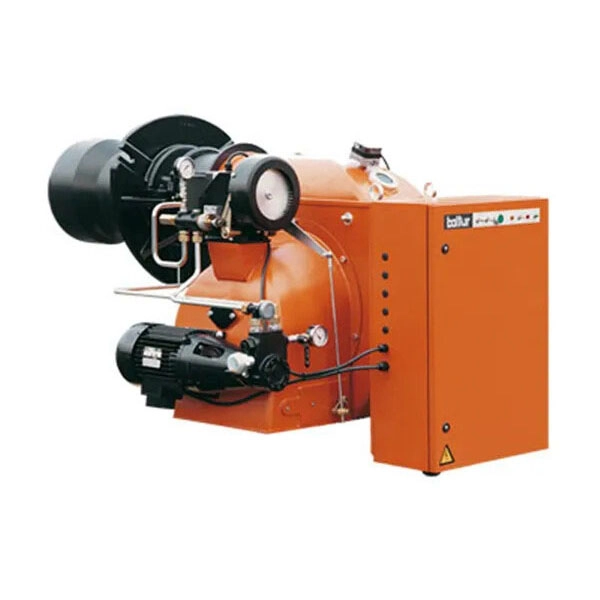
A diesel burner is a device that atomizes diesel fuel and mixes it with air to produce a controlled flame for heating purposes. Diesel burners are widely used in industrial furnaces, boilers, ovens, and kilns because diesel fuel is energy-dense, relatively safe to store, and provides stable combustion.
Diesel burners are devices that use diesel fuel to generate heat through combustion. They are widely used in various applications, from industrial furnaces and boilers to residential heating systems.
Fuel System:
Fuel Tank: Stores the diesel fuel.
Fuel Pump: Draws fuel from the tank and delivers it to the nozzle at the required pressure.
Fuel Filter: Removes impurities from the diesel to prevent clogging and damage to the burner components.
Pressure Regulator: Maintains a consistent fuel pressure for optimal atomization.
Solenoid Valve: An electrically controlled valve that opens and closes the fuel supply to the nozzle.
Air System:
Blower (Fan): Provides the necessary combustion air.
Air Damper/Regulator: Controls the amount of air entering the combustion chamber to achieve the correct fuel-to-air ratio.
Atomization System:
Nozzle: The critical component that atomizes the liquid diesel fuel into a fine mist of tiny droplets, increasing its surface area for efficient combustion. This can be achieved through pressure atomization (most common), air atomization, or rotary atomization.
Ignition System:
Ignition Transformer: Steps up voltage to create a high-voltage spark.
Ignition Electrodes: Two electrodes that create an arc across a gap, igniting the atomized fuel-air mixture.
Combustion Head/Chamber: Where the atomized fuel and air mix and combustion takes place. It's designed to stabilize the flame.
Control System:
Burner Control Box (Primary Control): The "brain" of the burner, responsible for managing the ignition sequence, flame monitoring, and safety shutdowns.
Flame Sensor (Photocell or UV Cell): Detects the presence of a flame. If no flame is detected during ignition or if the flame goes out during operation, the control box will shut down the burner for safety.
Thermostat/Pressurestat: external controls that signal the burner to turn on or off based on desired temperature or pressure.
Safety Devices: High-limit switches, low-water cutoffs (for boilers), pressure relief valves, etc., to prevent dangerous operating conditions.
The operation of a diesel burner follows a controlled sequence:
Call for Heat: An external control (e.g., thermostat) signals the burner to start.
Pre-Purge: The blower starts, forcing air through the combustion chamber to clear any unburnt fuel vapors, ensuring a safe start-up.
Ignition Sequence:
The ignition transformer energizes the ignition electrodes, creating a high-voltage spark.
Simultaneously, the fuel pump starts, drawing diesel from the tank, filtering it, and pushing it through the pressure regulator and open solenoid valve to the nozzle.
The nozzle atomizes the fuel into a fine spray.
Ignition and Flame Establishment: The atomized fuel mixes with combustion air from the blower and is ignited by the spark.
Flame Supervision: Once a stable flame is established, the flame sensor detects its presence, and the control box de-energizes the ignition transformer (the spark stops). The burner continues to operate.
Operation and Modulation: The burner continues to fire, generating heat. In more sophisticated burners, the fuel and air supply can be modulated (adjusted) to match the heat demand, improving efficiency.
Shutdown: When the call for heat ends, the fuel solenoid valve closes, cutting off the fuel supply. The blower may continue to run for a short "post-purge" period to clear any remaining combustion gases.
Safety Shutdown: If the flame sensor ever fails to detect a flame during operation, or if any other safety device trips, the control box will immediately shut down the burner and typically indicate a lockout condition, requiring manual reset.
Monoblock Burners: The most common type, where all components (fan, pump, controls) are integrated into a single unit. They are generally compact and easier to install.
Duoblock Burners: Larger industrial burners where the fan is separate from the main burner body. This allows for greater airflow and pressure capabilities.
Single-Stage Burners: Operate at a fixed firing rate (on/off).
Two-Stage Burners: Operate at two different firing rates (e.g., low fire and high fire), offering better efficiency by matching heat output to demand more closely.
Modulating Burners: Offer continuous adjustment of the firing rate across a range, providing the highest efficiency and precise temperature control.
Industrial:
Boilers (steam and hot water) for process heating, power generation.
Furnaces for heat treatment, metal melting, drying.
Incinerators.
Asphalt plants.
Kilns.
Commercial:
Large building heating systems.
Hotels, hospitals, schools.
Greenhouses.
Residential (less common now due to natural gas availability, but still present in some areas):
Oil-fired boilers and furnaces for home heating.
Agricultural:
Grain dryers.
Animal housing heating.
Take every customer request seriously.

Shuxin
Electromechanical
+86 15516359168
shuxin@sxburner.com
Room 504, Building 11, Wuzhou International Industrial Expo City, Old National Highway 310, Xigong District, Luoyang City, Henan Province
+86 15516359168
shuxin@sxburner.com
Room 504, Building 11, Wuzhou International Industrial Expo City, Old National Highway 310, Xigong District, Luoyang City, Henan Province